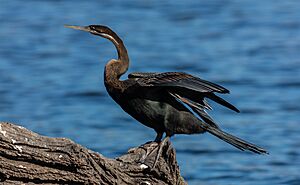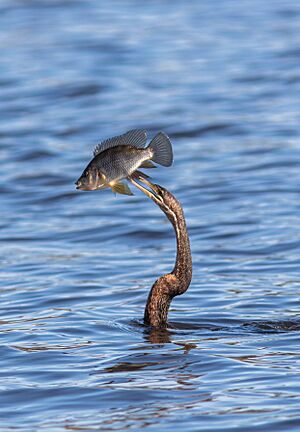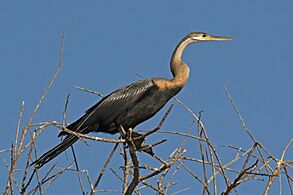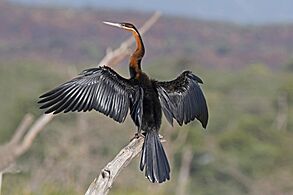African darter facts for kids
Quick facts for kids African darter |
|
|---|---|
 |
|
| in Botswana | |
| Conservation status | |
| Scientific classification | |
| Genus: |
Anhinga
|
| Species: |
rufa
|
 |
|
| Distribution map | |
| Synonyms | |
|
Anhinga africana |
|
The African darter (Anhinga rufa), also known as the snakebird, is a special water bird. It lives in parts of sub-Saharan Africa and Iraq. These birds are called "snakebirds" because they often swim with only their long necks above the water, looking like a snake!
Contents
What is an African Darter?
The African darter is part of the darter family, called Anhingidae. It is closely related to other darters found around the world. These include the American darter, the Oriental darter, and the Australasian darter.
How to Spot an African Darter
African darters are about 80 cm (31 in) long. They have a very long neck, just like other birds in the anhinga family.
- Males: Adult male darters are mostly shiny black. They have cool white stripes on their bodies.
- Females and Young Birds: Females and younger darters are usually browner.
- Special Mark: A key way to tell an African darter apart is its thin white stripe along the side of its neck. This stripe is on a reddish-brown background.
- Pointed Beak: Their sharp, pointed beak also helps you know it's a darter, not a cormorant.
Where Do African Darters Live?
African darters live all over sub-Saharan Africa. You can find them anywhere there are large bodies of water. This means they are quite common and widespread across the continent.
The Levant Darter
There was once a special type of African darter called the Levant darter (Anhinga rufa chantrei). This type lived outside Africa. They were found in places like Turkey, Israel, and the Mesopotamian Marshes in southern Iraq.
Sadly, the populations in Turkey and Israel disappeared. This happened because their wetland homes were drained in the 1930s and 1950s. The population in Iraq also faced big problems. They were affected by oil spills and the draining of the marshes after the Gulf War. However, a small group was found in the Hawizeh Marshes in 2007. The efforts to drain the marshes were stopped and even reversed after the Iraq War. This gave hope for the remaining birds.
How African Darters Behave

African darters build their nests from sticks in trees. They usually lay 3 to 6 eggs. They often nest near other water birds like herons, egrets, and cormorants.
Hunting for Food
These birds are excellent divers. They hunt for fish by diving underwater. They often swim with only their neck showing, which is why they are called "snakebirds." This helps them sneak up on fish.
Drying Their Feathers
Unlike many other water birds, the African darter's feathers do not have natural oil. This means their feathers are not waterproof. Because of this, they can sink easily, which helps them dive deep for fish.
However, after diving, their feathers can get very wet. To fly and stay warm, they need to dry their feathers. You will often see African darters sitting by the water. They spread their wings wide to dry them in the sun and wind. Cormorants, which live in the same areas, do this too.
Gallery






